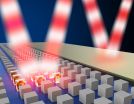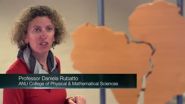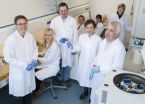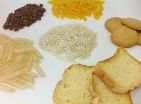(Press-News.org) WASHINGTON, Oct. 16—As in Alice's journey through the looking-glass to Wonderland, mirrors in the real world can sometimes behave in surprising and unexpected ways, including a new class of mirror that works like no other.
As reported today in The Optical Society's (OSA) new high-impact journal Optica, scientists have demonstrated, for the first time, a new type of mirror that forgoes a familiar shiny metallic surface and instead reflects infrared light by using an unusual magnetic property of a non-metallic metamaterial.
By placing nanoscale antennas at or very near the surface of these so-called "magnetic mirrors," scientists are able to capture and harness electromagnetic radiation in ways that have tantalizing potential in new classes of chemical sensors, solar cells, lasers, and other optoelectronic devices.
"We have achieved a new milestone in magnetic mirror technology by experimentally demonstrating this remarkable behavior of light at infrared wavelengths. Our breakthrough comes from using a specially engineered, non-metallic surface studded with nanoscale resonators," said Michael Sinclair, co-author on the Optica paper and a scientist at Sandia National Laboratories in Albuquerque, New Mexico, USA who co-led a research team with fellow author and Sandia scientist Igal Brener.
These nanoscale cube-shaped resonators, based on the element tellurium, are each considerably smaller than the width of a human hair and even tinier than the wavelengths of infrared light, which is essential to achieve magnetic-mirror behavior at these incredibly short wavelengths.
"The size and shape of the resonators are critical," explained Sinclair "as are their magnetic and electrical properties, all of which allow them to interact uniquely with light, scattering it across a specific range of wavelengths to produce a magnetic mirror effect."
Early Magnetic Mirror Designs
Conventional mirrors reflect light by interacting with the electrical component of electromagnetic radiation. Because of this, however, they do more than reverse the image; they also reverse light's electrical field. Though this has no impact on the human eye, it does have major implications in physics, especially at the point of reflection where the opposite incoming and outgoing electrical fields produce a canceling effect. This temporary squelching of light's electrical properties prevents components like nanoscale antennas and quantum dots from interacting with light at the mirror's surface.
A magnetic mirror, in contrast, reflects light by interacting with its magnetic field, preserving its original electrical properties. "A magnetic mirror, therefore, produces a very strong electric field at the mirror surface, enabling maximum absorption of the electromagnetic wave energy and paving the way for exciting new applications," said Brener.
Unlike silver and other metals, however, there is no natural material that reflects light magnetically. Magnetic fields can reflect and even bottle-up charged particles like electrons and protons. But photons, which have no charge, pass through freely.
"Nature simply doesn't provide a way to magnetically reflect light," explained Brener. Scientists, therefore, are developing metamaterials (materials not found in nature, engineered with specific properties) that are able to produce the magnetic-mirror effect.
Initially, this could only be achieved at long microwave frequencies, which would enable only a few applications, such as microwave antennas.
More recently, other researchers have achieved limited success at shorter wavelengths using "fish-scale" shaped metallic components. These designs, however, experienced considerable loss of signal, as well as an uneven response due to their particular shapes.
Mirrors Without Metals
To overcome these limitations, the team developed a specially engineered two-dimensional array of non-metallic dielectric resonators—nanoscale structures that strongly interact with the magnetic component of incoming light. These resonators have a number of important advantages over the earlier designs.
First, the dielectric material they use, tellurium, has much lower signal loss than do metals, making the new design much more reflective at infrared wavelengths and creating a much stronger electrical field at the mirror's surface. Second, the nanoscale resonators can be manufactured using standard deposition-lithography and etching processes, which are already widely used in industry.
The reflective properties of the resonators emerge because they behave, in some respects, like artificial atoms, absorbing and then reemitting photons. Atoms naturally do this by absorbing photons with their outer electrons and then reemitting the photons in random directions. This is how molecules in the atmosphere scatter specific wavelengths of light, causing the sky to appear blue during the day and red at sunrise and sunset.
The metamaterials in the resonators achieve a similar effect, but absorb and reemit photons without reversing their electric fields.
Proof of the Process
Confirming that the team's design was actually behaving like a magnetic mirror required exquisite measurements of how the light waves overlap as they pass each other coming in and reflecting off of the mirror surface. Since normal mirrors reverse the phase of light upon reflection, evidence that the phase signature of the wave was not reversed would be the "smoking gun" that the sample was behaving as a true magnetic mirror.
To make this detection, the Sandia team used a technique called time-domain spectroscopy, which has been widely used to measure phase at longer terahertz wavelengths. According to the researchers, only a few groups in the world have demonstrated this technique at shorter wavelengths (less than 10 microns). The power of this technique is that it can map both the amplitude and phase information of light's electric field.
"Our results clearly indicated that there was no phase reversal of the light," remarked Sheng Liu, Sandia postdoctoral associate and lead author on the Optica paper. "This was the ultimate demonstration that this patterned surface behaves like an optical magnetic mirror."
Next steps
Looking to the future, the researchers will investigate other materials to demonstrate magnetic mirror behavior at even shorter, optical wavelengths, where extremely broad applications can be found. "If efficient magnetic mirrors could be scaled to even shorter wavelengths, then they could enable smaller photodetectors, solar cells, and possibly lasers," Liu concluded.
INFORMATION:
Paper: S. Liu, M. B. Sinclair, T. S. Mahony, Y. C. Jun, S. Campione, J. Ginn, D. Bender, J. R. Wendt, J.F. Ihlefeld, P. G. Clem, J. B. Wright, I. Brener, "Optical Magnetic Mirrors without Metals," Optica 4, 247-253 (2014).
EDITOR'S NOTE: An image and advanced copy of the Optica paper are available to members of the media upon request. Contact Jake Lynn at optica@ecius.net or 202.296.2002.
About Optica
Optica is an open-access, online-only journal dedicated to the rapid dissemination of high-impact peer-reviewed research across the entire spectrum of optics and photonics. Published monthly by The Optical Society (OSA), Optica provides a forum for pioneering research to be swiftly accessed by the international community, whether that research is theoretical or experimental, fundamental or applied. Optica maintains a distinguished editorial board of more than 20 associate editors from around the world and is overseen by Editor-in-Chief Alex Gaeta of Cornell University. For more information, visit http://optica.osa.org.
About OSA
Founded in 1916, The Optical Society (OSA) is the leading professional organization for scientists, engineers, students and entrepreneurs who fuel discoveries, shape real-life applications and accelerate achievements in the science of light. Through world-renowned publications, meetings and membership initiatives, OSA provides quality research, inspired interactions and dedicated resources for its extensive global network of optics and photonics experts. OSA is a founding partner of the National Photonics Initiative and the 2015 International Year of Light. For more information, visit http://www.osa.org.
Magnetic mirrors enable new technologies by reflecting light in uncanny ways
2014-10-16
ELSE PRESS RELEASES FROM THIS DATE:
Scientists find ancient mountains that fed early life
2014-10-16
VIDEO:
Scientists from Australian National University reveal how they found a mountain range that fed an explosion of life 600 million years ago. The range stretched 2,500 km across Gondwana from...
Click here for more information.
Scientists have found evidence for a huge mountain range that sustained an explosion of life on Earth 600 million years ago.
The mountain range was similar in scale to the Himalayas and spanned at least 2,500 kilometres of modern west Africa and northeast ...
Plant communities produce greater yield than monocultures
2014-10-16
Although monocultures can be cultivated efficiently, they are anything but sustainable: environmental damage to soil and water caused by monoculture cultivation is becoming increasingly evident. Despite their disadvantages, however, monocultures remain the principal crop form and are regarded as the sole possibility of achieving higher yields in plant production – quite wrongfully, finds Bernhard Schmid, an ecology professor at the University of Zurich, who advocates a novel form of agriculture and forestry. After all, a new study carried out by PhD student Debra ...
New perspectives for development of an RSV vaccine
2014-10-16
Respiratory Syncytial Virus causes severe respiratory tract infections and worldwide claims the lives of 160,000 children each year. Scientists at VIB and Ghent University have succeeded in developing a promising vaccination strategy to counteract this common virus infection.
Xavier Saelens (VIB/UGent): "We discovered a new vaccination strategy that paves the way for the development of a novel approach to vaccination against RSV, a virus that causes suffering in numerous small children and elderly people."
RSV: an infection that is difficult to combat
The Respiratory ...
Mild traumatic brain injury can have lasting effects for families, reports the American Journal of Nursing
2014-10-16
October 16, 2014 – Families of patients with mild traumatic brain injury (TBI) may expect them to return to normal quickly—after all, it's "just a concussion." But mild TBI can have a lasting impact on families as well as patients, according to a review in the November issue of American Journal of Nursing. The journal is published by Lippincott Williams & Wilkins, a part of Wolters Kluwer Health.
"With the increasing numbers of people with mild TBI in the community, it's crucial for nurses to make this a part of assessment for early recognition and intervention," ...
Energy prices and business decision-making in Canada: Preparing for the energy future
2014-10-16
A new expert panel report, Energy Prices and Business Decision-Making in Canada: Preparing for the Energy Future, released today by the Council of Canadian Academies, details how Canadian businesses have historically been successful in responding to fluctuating energy prices, but this should not be considered a predictor for future resiliency or competiveness. The energy environment is evolving with advances in oil and gas extraction, the development of alternative energy sources, changes within the electricity market, and new regulatory requirements. Understanding the ...
The social web of things
2014-10-16
Research to be published in the International Journal of Web-Based Communities suggests that the familiar interfaces of online social networking sites might be adapted to allow us to interact more efficiently with our networked devices such as cars, domestic appliances and gadgets. The concept would also extend to the idea of those devices connecting with each other as necessary to improve efficiency of heating and lighting, make our home entertainment systems smarter and much more.
Are you Facebook friends with your microwave oven, is your car? Does your washing machine ...
Informative visit to the toilet
2014-10-16
Emily loves Justin - Stop global warming - Two more weeks till I graduate!: The exchange of information in public toilets is widespread. It also occurs in the world of white-footed sportive lemurs. Only instead of writing on the walls, they use scent-marks in order to communicate with their own kind. In a study published online in Springer's journal Behavioral Ecology and Sociobiology, Iris Dröscher and Peter Kappeler from the German Primate Center (DPZ) have found that the urine left on latrine trees serves as a method to maintain contact with family members. It also ...
Adenosine can melt 'love handles'
2014-10-16
The number of overweight persons is greatly increasing worldwide - and as a result is the risk of suffering a heart attack, stroke, diabetes or Alzheimer's disease. For this reason, many people dream of an efficient method for losing weight. An international team of researchers led by Professor Alexander Pfeifer from the University Hospital Bonn, have now come one step closer to this goal. The scientists discovered a new way to stimulate brown fat and thus burn energy from food: The body's own adenosine activates brown fat and "browns" white fat. The results are now being ...
Some rice-based foods for people with celiac disease contain relevant amounts of arsenic
2014-10-16
Rice is one of the few cereal grains consumed by people with celiac disease, as it does not contain gluten. However, it can have high concentrations of a toxic substance – arsenic – as revealed by the analyses of flour, cakes, bread, pasta and other foods made with rice, conducted by researchers from the Miguel Hernández University of Elche, Spain. The European Union is working to establish the maximum quantities of arsenic in these products.
Celiac disease affects almost 1% of the population of the western world, a group which cannot tolerate gluten ...
Pre-eclampsia may be caused by the fetus, not the placenta, says Anaesthesia editorial
2014-10-16
Pre-eclampsia, the potentially deadly condition that affects pregnant women, may be caused by problems meeting the oxygen demands of the growing fetus, according to an editorial in the November issue of Anaesthesia, the journal of the Association of Anaesthetists of Great Britain and Ireland (AAGBI).
The finding has promoted the co-author of the editorial, Associate Professor Alicia Dennis, Consultant Anaesthetist & Director of Anaesthesia Research at the Royal Women's Hospital in Melbourne, Australia, to call for the name of the condition to be changed to make women ...





